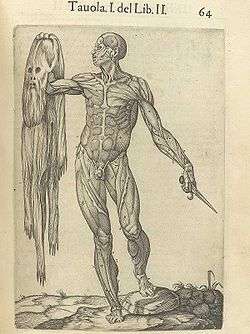Juan Valverde de Amusco

Juan Valverde de Amusco (or "de Hamusco") (c. 1525-?) was born in the Kingdom of León in what is now Spain in about the year 1525 and studied medicine in Padua and Rome under Realdo Columbo and Bartolomeo Eustachi. He published several works on anatomy, including De animi et corporis sanitate tuenda libellus (Paris, 1552).
Valverde's most famous work was Historia de la composicion del cuerpo humano, first published in Rome, 1556. All but four of its 42 engraved copperplate illustrations were taken almost directly from Andreas Vesalius's De humani corporis fabrica. Vesalius bitterly commented on Valverde's plagiarism, accusing him of having performed very few dissections himself. Occasionally, however, Valverde corrected Vesalius' images, as in his depictions of the muscles of the eyes, nose, and larynx. One of Valverde's most striking original plates is that of a muscle figure holding his own skin in one hand and a knife in the other, which has been likened to Saint Bartholomew in The Last Judgment (Michelangelo) of the Sistine Chapel.
The original illustrations were most likely drawn by Gaspar Becerra (1520–1570), a contemporary of Michelangelo, and the copperplate engravings are thought to have been carried out by Nicolas Beatrizet (1507?-1570?), whose initials "NB" appear on several of the plates.
Sources
- Adapted from public domain text at Juan Valverde de Amusco Biography.[1] Historical Anatomies on the Web. US National Library of Medicine.
References
- ↑ "Historical Anatomies on the Web: Valverde: Author & Title Description". Nlm.nih.gov. 2010-12-14. Retrieved 2012-06-13.
- Choulant, L. History and bibliography of anatomic illustration. Trans. and annotated by Mortimer Frank. (New York: Hafner, 1962), pp. 205–208.
- Cushing, Harvey. A Bio-Bibliography of Andreas Vesalius. (New York: Schuman's, 1943), pp. 146–148.
| Wikimedia Commons has media related to Juan Valverde de Amusco. |
External links
- Historical Anatomies on the Web. US National Library of Medicine. Selected pages scanned from the original work.
- Wolfe, Susan. "Juan Valverde de Amusco." On the website, "The Boundaries of the Body and Scientific Illustration in Early Modern Europe."
- Wolfe, Susan. "Peeling off the skin: revealing alternate meanings of Valverde's muscle man." On the website, "The Boundaries of the Body and Scientific Illustration in Early Modern Europe."
- Images from Historia de la composicion del cuerpo humano From The College of Physicians of Philadelphia Digital Library
- Images from the Edition Antwerp, Plantin, 1568 Royal Dutch Society for Medicine (KNMG), Amsterdam Special Collections.